Chemotherapy of Lung Cancer
VerifiedAdded on 2023/03/17
|14
|4448
|29
AI Summary
This article discusses the chemotherapy of lung cancer, including its subtypes, secondary liver cancer, pharmacokinetics and pharmacodynamics of Cisplatin and Docetaxel, and the effectiveness of chemotherapy medications in treating lung cancer.
Contribute Materials
Your contribution can guide someone’s learning journey. Share your
documents today.
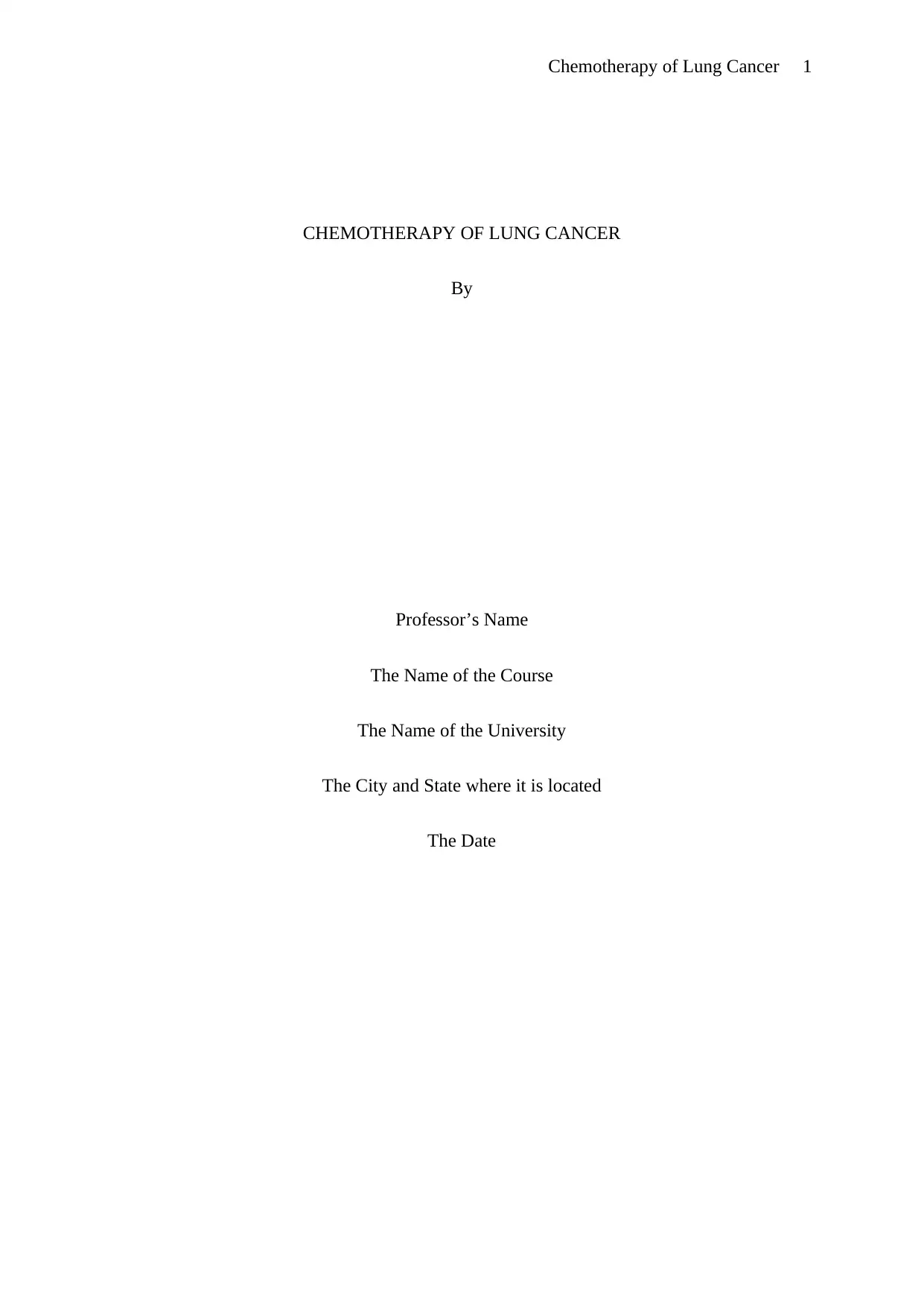
Chemotherapy of Lung Cancer 1
CHEMOTHERAPY OF LUNG CANCER
By
Professor’s Name
The Name of the Course
The Name of the University
The City and State where it is located
The Date
CHEMOTHERAPY OF LUNG CANCER
By
Professor’s Name
The Name of the Course
The Name of the University
The City and State where it is located
The Date
Secure Best Marks with AI Grader
Need help grading? Try our AI Grader for instant feedback on your assignments.
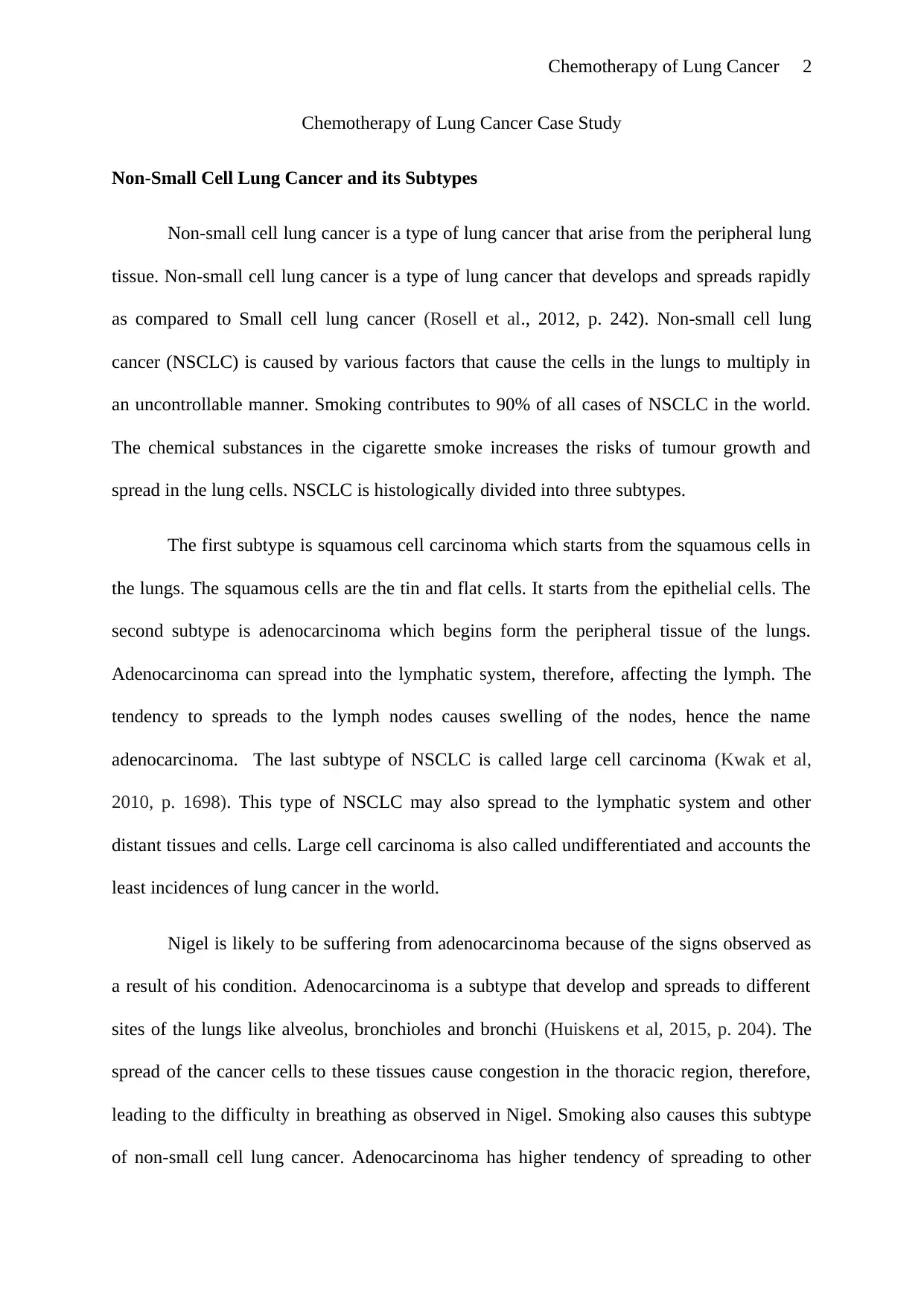
Chemotherapy of Lung Cancer 2
Chemotherapy of Lung Cancer Case Study
Non-Small Cell Lung Cancer and its Subtypes
Non-small cell lung cancer is a type of lung cancer that arise from the peripheral lung
tissue. Non-small cell lung cancer is a type of lung cancer that develops and spreads rapidly
as compared to Small cell lung cancer (Rosell et al., 2012, p. 242). Non-small cell lung
cancer (NSCLC) is caused by various factors that cause the cells in the lungs to multiply in
an uncontrollable manner. Smoking contributes to 90% of all cases of NSCLC in the world.
The chemical substances in the cigarette smoke increases the risks of tumour growth and
spread in the lung cells. NSCLC is histologically divided into three subtypes.
The first subtype is squamous cell carcinoma which starts from the squamous cells in
the lungs. The squamous cells are the tin and flat cells. It starts from the epithelial cells. The
second subtype is adenocarcinoma which begins form the peripheral tissue of the lungs.
Adenocarcinoma can spread into the lymphatic system, therefore, affecting the lymph. The
tendency to spreads to the lymph nodes causes swelling of the nodes, hence the name
adenocarcinoma. The last subtype of NSCLC is called large cell carcinoma (Kwak et al,
2010, p. 1698). This type of NSCLC may also spread to the lymphatic system and other
distant tissues and cells. Large cell carcinoma is also called undifferentiated and accounts the
least incidences of lung cancer in the world.
Nigel is likely to be suffering from adenocarcinoma because of the signs observed as
a result of his condition. Adenocarcinoma is a subtype that develop and spreads to different
sites of the lungs like alveolus, bronchioles and bronchi (Huiskens et al, 2015, p. 204). The
spread of the cancer cells to these tissues cause congestion in the thoracic region, therefore,
leading to the difficulty in breathing as observed in Nigel. Smoking also causes this subtype
of non-small cell lung cancer. Adenocarcinoma has higher tendency of spreading to other
Chemotherapy of Lung Cancer Case Study
Non-Small Cell Lung Cancer and its Subtypes
Non-small cell lung cancer is a type of lung cancer that arise from the peripheral lung
tissue. Non-small cell lung cancer is a type of lung cancer that develops and spreads rapidly
as compared to Small cell lung cancer (Rosell et al., 2012, p. 242). Non-small cell lung
cancer (NSCLC) is caused by various factors that cause the cells in the lungs to multiply in
an uncontrollable manner. Smoking contributes to 90% of all cases of NSCLC in the world.
The chemical substances in the cigarette smoke increases the risks of tumour growth and
spread in the lung cells. NSCLC is histologically divided into three subtypes.
The first subtype is squamous cell carcinoma which starts from the squamous cells in
the lungs. The squamous cells are the tin and flat cells. It starts from the epithelial cells. The
second subtype is adenocarcinoma which begins form the peripheral tissue of the lungs.
Adenocarcinoma can spread into the lymphatic system, therefore, affecting the lymph. The
tendency to spreads to the lymph nodes causes swelling of the nodes, hence the name
adenocarcinoma. The last subtype of NSCLC is called large cell carcinoma (Kwak et al,
2010, p. 1698). This type of NSCLC may also spread to the lymphatic system and other
distant tissues and cells. Large cell carcinoma is also called undifferentiated and accounts the
least incidences of lung cancer in the world.
Nigel is likely to be suffering from adenocarcinoma because of the signs observed as
a result of his condition. Adenocarcinoma is a subtype that develop and spreads to different
sites of the lungs like alveolus, bronchioles and bronchi (Huiskens et al, 2015, p. 204). The
spread of the cancer cells to these tissues cause congestion in the thoracic region, therefore,
leading to the difficulty in breathing as observed in Nigel. Smoking also causes this subtype
of non-small cell lung cancer. Adenocarcinoma has higher tendency of spreading to other
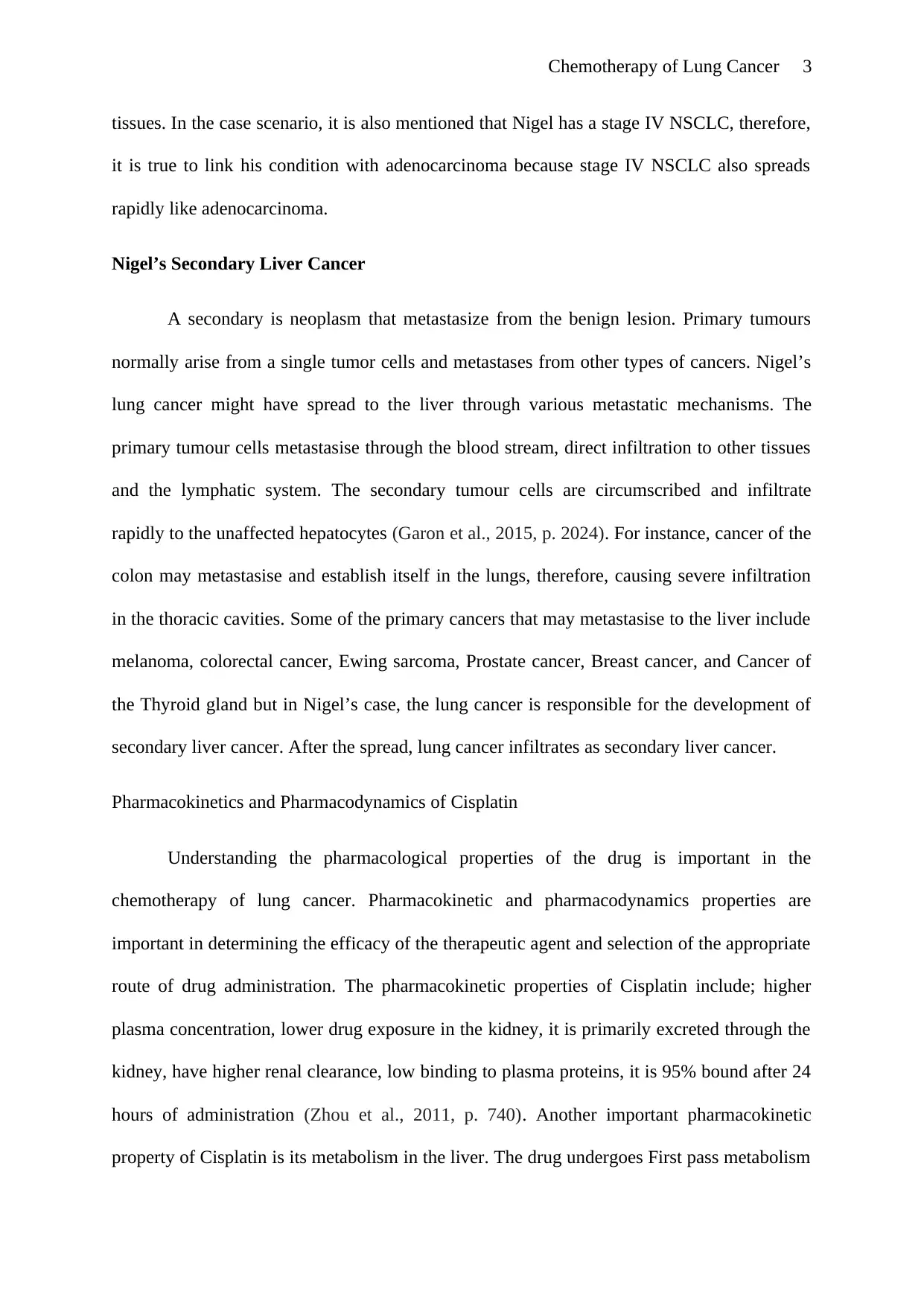
Chemotherapy of Lung Cancer 3
tissues. In the case scenario, it is also mentioned that Nigel has a stage IV NSCLC, therefore,
it is true to link his condition with adenocarcinoma because stage IV NSCLC also spreads
rapidly like adenocarcinoma.
Nigel’s Secondary Liver Cancer
A secondary is neoplasm that metastasize from the benign lesion. Primary tumours
normally arise from a single tumor cells and metastases from other types of cancers. Nigel’s
lung cancer might have spread to the liver through various metastatic mechanisms. The
primary tumour cells metastasise through the blood stream, direct infiltration to other tissues
and the lymphatic system. The secondary tumour cells are circumscribed and infiltrate
rapidly to the unaffected hepatocytes (Garon et al., 2015, p. 2024). For instance, cancer of the
colon may metastasise and establish itself in the lungs, therefore, causing severe infiltration
in the thoracic cavities. Some of the primary cancers that may metastasise to the liver include
melanoma, colorectal cancer, Ewing sarcoma, Prostate cancer, Breast cancer, and Cancer of
the Thyroid gland but in Nigel’s case, the lung cancer is responsible for the development of
secondary liver cancer. After the spread, lung cancer infiltrates as secondary liver cancer.
Pharmacokinetics and Pharmacodynamics of Cisplatin
Understanding the pharmacological properties of the drug is important in the
chemotherapy of lung cancer. Pharmacokinetic and pharmacodynamics properties are
important in determining the efficacy of the therapeutic agent and selection of the appropriate
route of drug administration. The pharmacokinetic properties of Cisplatin include; higher
plasma concentration, lower drug exposure in the kidney, it is primarily excreted through the
kidney, have higher renal clearance, low binding to plasma proteins, it is 95% bound after 24
hours of administration (Zhou et al., 2011, p. 740). Another important pharmacokinetic
property of Cisplatin is its metabolism in the liver. The drug undergoes First pass metabolism
tissues. In the case scenario, it is also mentioned that Nigel has a stage IV NSCLC, therefore,
it is true to link his condition with adenocarcinoma because stage IV NSCLC also spreads
rapidly like adenocarcinoma.
Nigel’s Secondary Liver Cancer
A secondary is neoplasm that metastasize from the benign lesion. Primary tumours
normally arise from a single tumor cells and metastases from other types of cancers. Nigel’s
lung cancer might have spread to the liver through various metastatic mechanisms. The
primary tumour cells metastasise through the blood stream, direct infiltration to other tissues
and the lymphatic system. The secondary tumour cells are circumscribed and infiltrate
rapidly to the unaffected hepatocytes (Garon et al., 2015, p. 2024). For instance, cancer of the
colon may metastasise and establish itself in the lungs, therefore, causing severe infiltration
in the thoracic cavities. Some of the primary cancers that may metastasise to the liver include
melanoma, colorectal cancer, Ewing sarcoma, Prostate cancer, Breast cancer, and Cancer of
the Thyroid gland but in Nigel’s case, the lung cancer is responsible for the development of
secondary liver cancer. After the spread, lung cancer infiltrates as secondary liver cancer.
Pharmacokinetics and Pharmacodynamics of Cisplatin
Understanding the pharmacological properties of the drug is important in the
chemotherapy of lung cancer. Pharmacokinetic and pharmacodynamics properties are
important in determining the efficacy of the therapeutic agent and selection of the appropriate
route of drug administration. The pharmacokinetic properties of Cisplatin include; higher
plasma concentration, lower drug exposure in the kidney, it is primarily excreted through the
kidney, have higher renal clearance, low binding to plasma proteins, it is 95% bound after 24
hours of administration (Zhou et al., 2011, p. 740). Another important pharmacokinetic
property of Cisplatin is its metabolism in the liver. The drug undergoes First pass metabolism
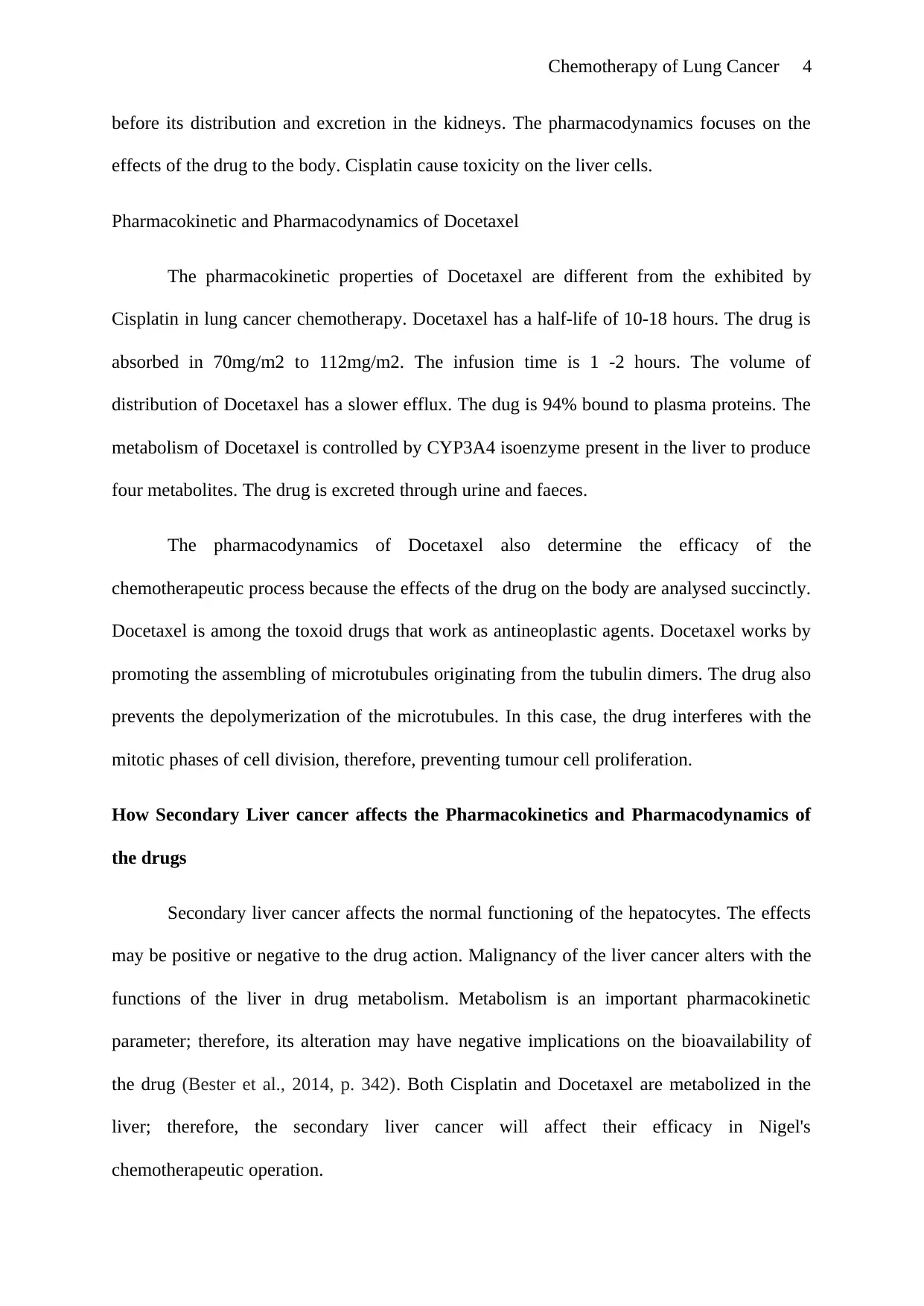
Chemotherapy of Lung Cancer 4
before its distribution and excretion in the kidneys. The pharmacodynamics focuses on the
effects of the drug to the body. Cisplatin cause toxicity on the liver cells.
Pharmacokinetic and Pharmacodynamics of Docetaxel
The pharmacokinetic properties of Docetaxel are different from the exhibited by
Cisplatin in lung cancer chemotherapy. Docetaxel has a half-life of 10-18 hours. The drug is
absorbed in 70mg/m2 to 112mg/m2. The infusion time is 1 -2 hours. The volume of
distribution of Docetaxel has a slower efflux. The dug is 94% bound to plasma proteins. The
metabolism of Docetaxel is controlled by CYP3A4 isoenzyme present in the liver to produce
four metabolites. The drug is excreted through urine and faeces.
The pharmacodynamics of Docetaxel also determine the efficacy of the
chemotherapeutic process because the effects of the drug on the body are analysed succinctly.
Docetaxel is among the toxoid drugs that work as antineoplastic agents. Docetaxel works by
promoting the assembling of microtubules originating from the tubulin dimers. The drug also
prevents the depolymerization of the microtubules. In this case, the drug interferes with the
mitotic phases of cell division, therefore, preventing tumour cell proliferation.
How Secondary Liver cancer affects the Pharmacokinetics and Pharmacodynamics of
the drugs
Secondary liver cancer affects the normal functioning of the hepatocytes. The effects
may be positive or negative to the drug action. Malignancy of the liver cancer alters with the
functions of the liver in drug metabolism. Metabolism is an important pharmacokinetic
parameter; therefore, its alteration may have negative implications on the bioavailability of
the drug (Bester et al., 2014, p. 342). Both Cisplatin and Docetaxel are metabolized in the
liver; therefore, the secondary liver cancer will affect their efficacy in Nigel's
chemotherapeutic operation.
before its distribution and excretion in the kidneys. The pharmacodynamics focuses on the
effects of the drug to the body. Cisplatin cause toxicity on the liver cells.
Pharmacokinetic and Pharmacodynamics of Docetaxel
The pharmacokinetic properties of Docetaxel are different from the exhibited by
Cisplatin in lung cancer chemotherapy. Docetaxel has a half-life of 10-18 hours. The drug is
absorbed in 70mg/m2 to 112mg/m2. The infusion time is 1 -2 hours. The volume of
distribution of Docetaxel has a slower efflux. The dug is 94% bound to plasma proteins. The
metabolism of Docetaxel is controlled by CYP3A4 isoenzyme present in the liver to produce
four metabolites. The drug is excreted through urine and faeces.
The pharmacodynamics of Docetaxel also determine the efficacy of the
chemotherapeutic process because the effects of the drug on the body are analysed succinctly.
Docetaxel is among the toxoid drugs that work as antineoplastic agents. Docetaxel works by
promoting the assembling of microtubules originating from the tubulin dimers. The drug also
prevents the depolymerization of the microtubules. In this case, the drug interferes with the
mitotic phases of cell division, therefore, preventing tumour cell proliferation.
How Secondary Liver cancer affects the Pharmacokinetics and Pharmacodynamics of
the drugs
Secondary liver cancer affects the normal functioning of the hepatocytes. The effects
may be positive or negative to the drug action. Malignancy of the liver cancer alters with the
functions of the liver in drug metabolism. Metabolism is an important pharmacokinetic
parameter; therefore, its alteration may have negative implications on the bioavailability of
the drug (Bester et al., 2014, p. 342). Both Cisplatin and Docetaxel are metabolized in the
liver; therefore, the secondary liver cancer will affect their efficacy in Nigel's
chemotherapeutic operation.
Secure Best Marks with AI Grader
Need help grading? Try our AI Grader for instant feedback on your assignments.

Chemotherapy of Lung Cancer 5
On the other hand, the secondary liver cancer observed on Nigel may also improve
the efficacy of the drugs in the chemotherapeutic process. This is because the damage of the
liver cells will lead to reduced first pass effects. First pass metabolism affects the
concentration of the drug metabolites to be distributed to various tissue in the body, therefore,
reduces the efficacy of the chemotherapeutic agents.
How Chemotherapy Medications can be Effective in Treating Nigel’s Lung Cancer
Nigel is undergoing chronic lung cancer that has made her lose hope in the
chemotherapeutic operation. The mechanisms of actions of agents determine their efficacy in
the treatment of Nigel’s condition. Evidence-based practices have led to the identification of
Cisplatin as an effective agent in lung cancer chemotherapy (Temel et al., 2010, p. 736).
Through a series of surveys, investigation has been based on the variability of the toxicity and
outcome of Cisplatin. The effects of Cisplatin are specific to the tumour cells; therefore, does
not cause serious adverse effects on the host’s cells. Cisplatin is one of the alkylating agents
used in the chemotherapy of lung and breast cancer. The efficacy of the drug is based on its
ability to interfere with DNA replication, therefore, preventing the spread of the cancer cells
to all to the uninfected lung tissue. Cisplatin also prevents the metastasis of the primary
tumour cells to other parts of the body.
Morphine IV is used as a pain reliever in chemotherapy. Chest pain is one of the
symptoms of lung cancer. Chronic congestion and inflammation in the lungs cause severe
pain; therefore, it is important to use pain relievers to assist in reverting the progression of the
disease symptoms. Opioids are essential drugs used in cancer chemotherapy because of their
ability to revert pain caused by inflammation and congestion. Morphine IV is typical of these
Opioids. Subcutaneous and intravenous routes of administration are preferable for the
effective performance of Morphine IV (Beljanski and Hall, 2014, p. 108). Continuous
On the other hand, the secondary liver cancer observed on Nigel may also improve
the efficacy of the drugs in the chemotherapeutic process. This is because the damage of the
liver cells will lead to reduced first pass effects. First pass metabolism affects the
concentration of the drug metabolites to be distributed to various tissue in the body, therefore,
reduces the efficacy of the chemotherapeutic agents.
How Chemotherapy Medications can be Effective in Treating Nigel’s Lung Cancer
Nigel is undergoing chronic lung cancer that has made her lose hope in the
chemotherapeutic operation. The mechanisms of actions of agents determine their efficacy in
the treatment of Nigel’s condition. Evidence-based practices have led to the identification of
Cisplatin as an effective agent in lung cancer chemotherapy (Temel et al., 2010, p. 736).
Through a series of surveys, investigation has been based on the variability of the toxicity and
outcome of Cisplatin. The effects of Cisplatin are specific to the tumour cells; therefore, does
not cause serious adverse effects on the host’s cells. Cisplatin is one of the alkylating agents
used in the chemotherapy of lung and breast cancer. The efficacy of the drug is based on its
ability to interfere with DNA replication, therefore, preventing the spread of the cancer cells
to all to the uninfected lung tissue. Cisplatin also prevents the metastasis of the primary
tumour cells to other parts of the body.
Morphine IV is used as a pain reliever in chemotherapy. Chest pain is one of the
symptoms of lung cancer. Chronic congestion and inflammation in the lungs cause severe
pain; therefore, it is important to use pain relievers to assist in reverting the progression of the
disease symptoms. Opioids are essential drugs used in cancer chemotherapy because of their
ability to revert pain caused by inflammation and congestion. Morphine IV is typical of these
Opioids. Subcutaneous and intravenous routes of administration are preferable for the
effective performance of Morphine IV (Beljanski and Hall, 2014, p. 108). Continuous
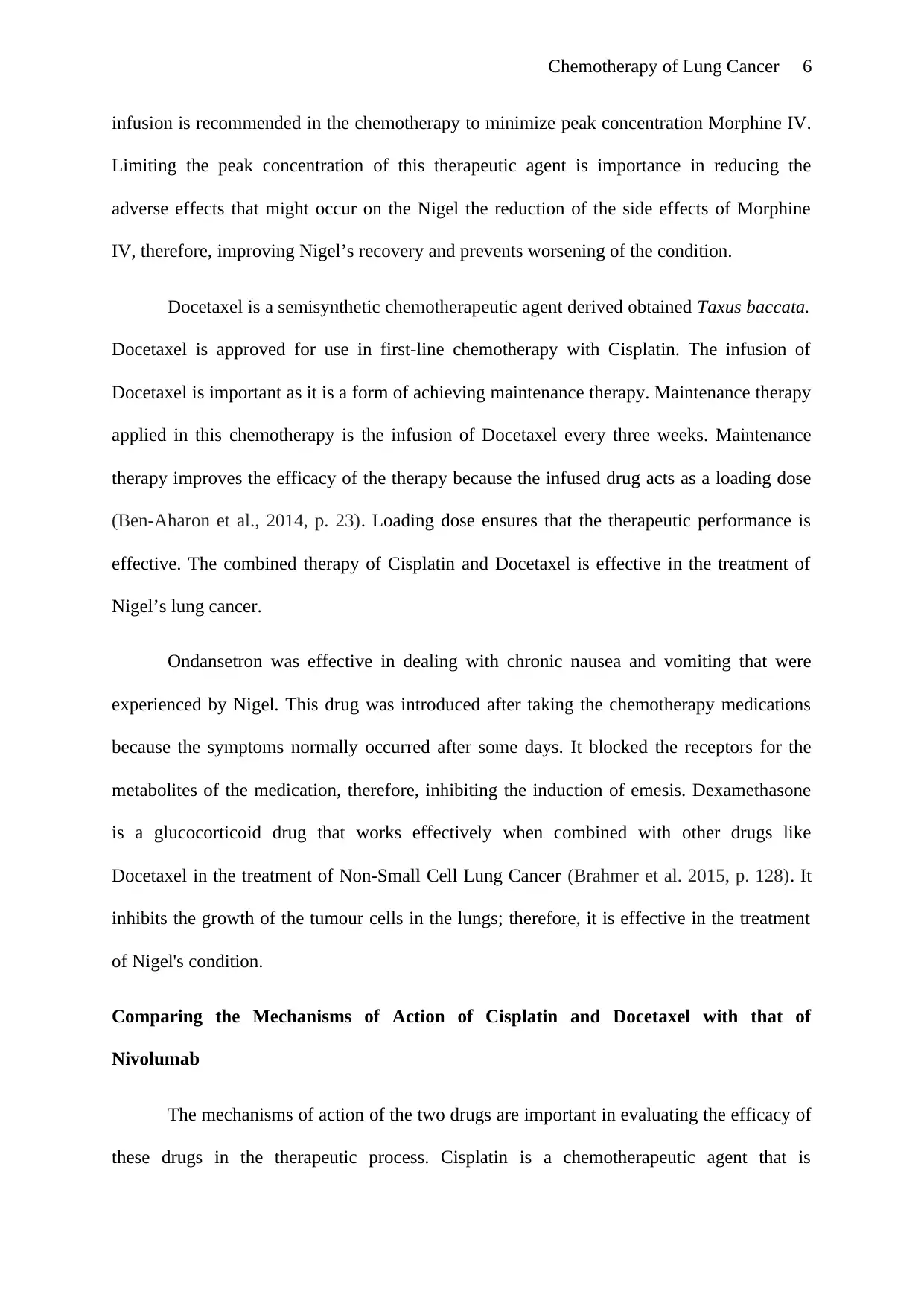
Chemotherapy of Lung Cancer 6
infusion is recommended in the chemotherapy to minimize peak concentration Morphine IV.
Limiting the peak concentration of this therapeutic agent is importance in reducing the
adverse effects that might occur on the Nigel the reduction of the side effects of Morphine
IV, therefore, improving Nigel’s recovery and prevents worsening of the condition.
Docetaxel is a semisynthetic chemotherapeutic agent derived obtained Taxus baccata.
Docetaxel is approved for use in first-line chemotherapy with Cisplatin. The infusion of
Docetaxel is important as it is a form of achieving maintenance therapy. Maintenance therapy
applied in this chemotherapy is the infusion of Docetaxel every three weeks. Maintenance
therapy improves the efficacy of the therapy because the infused drug acts as a loading dose
(Ben-Aharon et al., 2014, p. 23). Loading dose ensures that the therapeutic performance is
effective. The combined therapy of Cisplatin and Docetaxel is effective in the treatment of
Nigel’s lung cancer.
Ondansetron was effective in dealing with chronic nausea and vomiting that were
experienced by Nigel. This drug was introduced after taking the chemotherapy medications
because the symptoms normally occurred after some days. It blocked the receptors for the
metabolites of the medication, therefore, inhibiting the induction of emesis. Dexamethasone
is a glucocorticoid drug that works effectively when combined with other drugs like
Docetaxel in the treatment of Non-Small Cell Lung Cancer (Brahmer et al. 2015, p. 128). It
inhibits the growth of the tumour cells in the lungs; therefore, it is effective in the treatment
of Nigel's condition.
Comparing the Mechanisms of Action of Cisplatin and Docetaxel with that of
Nivolumab
The mechanisms of action of the two drugs are important in evaluating the efficacy of
these drugs in the therapeutic process. Cisplatin is a chemotherapeutic agent that is
infusion is recommended in the chemotherapy to minimize peak concentration Morphine IV.
Limiting the peak concentration of this therapeutic agent is importance in reducing the
adverse effects that might occur on the Nigel the reduction of the side effects of Morphine
IV, therefore, improving Nigel’s recovery and prevents worsening of the condition.
Docetaxel is a semisynthetic chemotherapeutic agent derived obtained Taxus baccata.
Docetaxel is approved for use in first-line chemotherapy with Cisplatin. The infusion of
Docetaxel is important as it is a form of achieving maintenance therapy. Maintenance therapy
applied in this chemotherapy is the infusion of Docetaxel every three weeks. Maintenance
therapy improves the efficacy of the therapy because the infused drug acts as a loading dose
(Ben-Aharon et al., 2014, p. 23). Loading dose ensures that the therapeutic performance is
effective. The combined therapy of Cisplatin and Docetaxel is effective in the treatment of
Nigel’s lung cancer.
Ondansetron was effective in dealing with chronic nausea and vomiting that were
experienced by Nigel. This drug was introduced after taking the chemotherapy medications
because the symptoms normally occurred after some days. It blocked the receptors for the
metabolites of the medication, therefore, inhibiting the induction of emesis. Dexamethasone
is a glucocorticoid drug that works effectively when combined with other drugs like
Docetaxel in the treatment of Non-Small Cell Lung Cancer (Brahmer et al. 2015, p. 128). It
inhibits the growth of the tumour cells in the lungs; therefore, it is effective in the treatment
of Nigel's condition.
Comparing the Mechanisms of Action of Cisplatin and Docetaxel with that of
Nivolumab
The mechanisms of action of the two drugs are important in evaluating the efficacy of
these drugs in the therapeutic process. Cisplatin is a chemotherapeutic agent that is
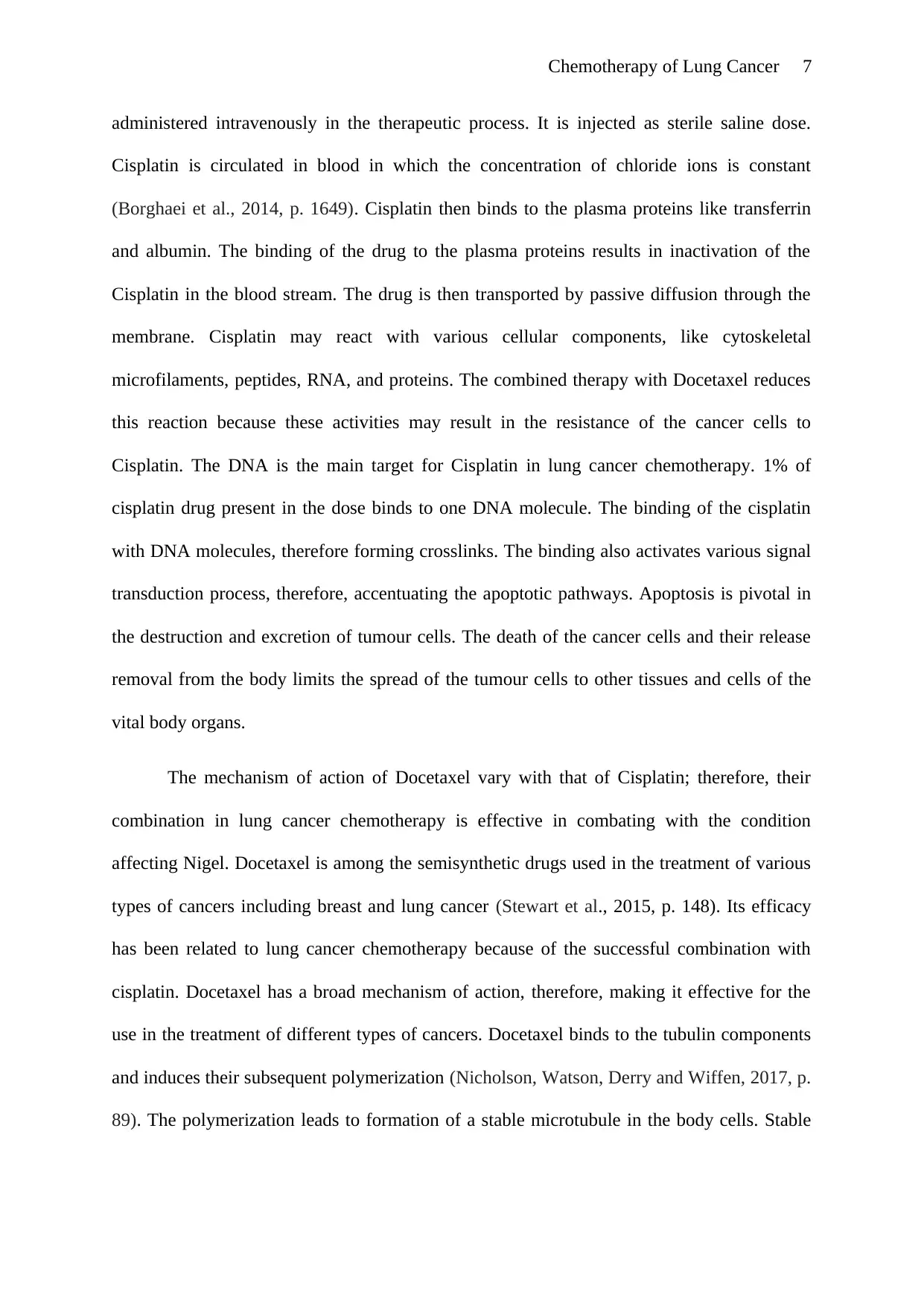
Chemotherapy of Lung Cancer 7
administered intravenously in the therapeutic process. It is injected as sterile saline dose.
Cisplatin is circulated in blood in which the concentration of chloride ions is constant
(Borghaei et al., 2014, p. 1649). Cisplatin then binds to the plasma proteins like transferrin
and albumin. The binding of the drug to the plasma proteins results in inactivation of the
Cisplatin in the blood stream. The drug is then transported by passive diffusion through the
membrane. Cisplatin may react with various cellular components, like cytoskeletal
microfilaments, peptides, RNA, and proteins. The combined therapy with Docetaxel reduces
this reaction because these activities may result in the resistance of the cancer cells to
Cisplatin. The DNA is the main target for Cisplatin in lung cancer chemotherapy. 1% of
cisplatin drug present in the dose binds to one DNA molecule. The binding of the cisplatin
with DNA molecules, therefore forming crosslinks. The binding also activates various signal
transduction process, therefore, accentuating the apoptotic pathways. Apoptosis is pivotal in
the destruction and excretion of tumour cells. The death of the cancer cells and their release
removal from the body limits the spread of the tumour cells to other tissues and cells of the
vital body organs.
The mechanism of action of Docetaxel vary with that of Cisplatin; therefore, their
combination in lung cancer chemotherapy is effective in combating with the condition
affecting Nigel. Docetaxel is among the semisynthetic drugs used in the treatment of various
types of cancers including breast and lung cancer (Stewart et al., 2015, p. 148). Its efficacy
has been related to lung cancer chemotherapy because of the successful combination with
cisplatin. Docetaxel has a broad mechanism of action, therefore, making it effective for the
use in the treatment of different types of cancers. Docetaxel binds to the tubulin components
and induces their subsequent polymerization (Nicholson, Watson, Derry and Wiffen, 2017, p.
89). The polymerization leads to formation of a stable microtubule in the body cells. Stable
administered intravenously in the therapeutic process. It is injected as sterile saline dose.
Cisplatin is circulated in blood in which the concentration of chloride ions is constant
(Borghaei et al., 2014, p. 1649). Cisplatin then binds to the plasma proteins like transferrin
and albumin. The binding of the drug to the plasma proteins results in inactivation of the
Cisplatin in the blood stream. The drug is then transported by passive diffusion through the
membrane. Cisplatin may react with various cellular components, like cytoskeletal
microfilaments, peptides, RNA, and proteins. The combined therapy with Docetaxel reduces
this reaction because these activities may result in the resistance of the cancer cells to
Cisplatin. The DNA is the main target for Cisplatin in lung cancer chemotherapy. 1% of
cisplatin drug present in the dose binds to one DNA molecule. The binding of the cisplatin
with DNA molecules, therefore forming crosslinks. The binding also activates various signal
transduction process, therefore, accentuating the apoptotic pathways. Apoptosis is pivotal in
the destruction and excretion of tumour cells. The death of the cancer cells and their release
removal from the body limits the spread of the tumour cells to other tissues and cells of the
vital body organs.
The mechanism of action of Docetaxel vary with that of Cisplatin; therefore, their
combination in lung cancer chemotherapy is effective in combating with the condition
affecting Nigel. Docetaxel is among the semisynthetic drugs used in the treatment of various
types of cancers including breast and lung cancer (Stewart et al., 2015, p. 148). Its efficacy
has been related to lung cancer chemotherapy because of the successful combination with
cisplatin. Docetaxel has a broad mechanism of action, therefore, making it effective for the
use in the treatment of different types of cancers. Docetaxel binds to the tubulin components
and induces their subsequent polymerization (Nicholson, Watson, Derry and Wiffen, 2017, p.
89). The polymerization leads to formation of a stable microtubule in the body cells. Stable
Paraphrase This Document
Need a fresh take? Get an instant paraphrase of this document with our AI Paraphraser

Chemotherapy of Lung Cancer 8
polymerized structure of the body cells inhibits the uncontrolled proliferation and metastasis
of the cancerous cells to other parts of the body.
Nivolumab is an anticancer drug that targets the immunologic components involved
in the replication and spread of the cancerous cells (Nowacki et al., 2017, p. 42). PD-1 is one
of the molecules belonging to CD28 T- cells target receptors. PD- is mainly expressed in B-
lymphocytes, T- lymphocytes and myeloid cells. The member of the CD28 cell receptor is
not regulated following a chronic stimulation of an antigen, therefore, producing a
mechanism of T- lymphocyte exhaustion. The exhaustion of the T-cells lead to the release of
inflammatory cytokines in the body like interferon gamma. The presence of the cytokines in
the body induces various ligand systems. The binding of the induced ligands leads to an
inhibition mechanism involving the T- cells. The inhibition of the T-cells interferes with the
immune responses of the body (National Lung Screening Trial Research Team, 2011, p. 408).
In this case, the use of nivolumab is effective in the reduction of the inhibitory function of the
ligands, therefore, boosting the immunity of the body to the spread of the tumor cells. In
comparison with the two therapeutic agents, nivolumab is effective because its mechanism of
action improves the immune response of the body; therefore, it should be prescribed for use
in the treatment of Nigel's lung cancer. Immunotherapy is an effective intervention in the
treatment of lung cancer.
How Chemotherapy Medication Caused Nausea and Vomiting
Nausea and vomiting are among the common symptoms of different types of cancers
(Reck et al., 2016, p. 1818). The nausea and vomiting presented by Nigel are occurred due to
various mechanisms; therefore, inducing emesis. The cause of nausea is not well known
unlike vomiting; the mechanisms that cause emesis are linked to nausea because vomiting
and nausea are close symptoms that normally accompany each other. Emesis occurred in
polymerized structure of the body cells inhibits the uncontrolled proliferation and metastasis
of the cancerous cells to other parts of the body.
Nivolumab is an anticancer drug that targets the immunologic components involved
in the replication and spread of the cancerous cells (Nowacki et al., 2017, p. 42). PD-1 is one
of the molecules belonging to CD28 T- cells target receptors. PD- is mainly expressed in B-
lymphocytes, T- lymphocytes and myeloid cells. The member of the CD28 cell receptor is
not regulated following a chronic stimulation of an antigen, therefore, producing a
mechanism of T- lymphocyte exhaustion. The exhaustion of the T-cells lead to the release of
inflammatory cytokines in the body like interferon gamma. The presence of the cytokines in
the body induces various ligand systems. The binding of the induced ligands leads to an
inhibition mechanism involving the T- cells. The inhibition of the T-cells interferes with the
immune responses of the body (National Lung Screening Trial Research Team, 2011, p. 408).
In this case, the use of nivolumab is effective in the reduction of the inhibitory function of the
ligands, therefore, boosting the immunity of the body to the spread of the tumor cells. In
comparison with the two therapeutic agents, nivolumab is effective because its mechanism of
action improves the immune response of the body; therefore, it should be prescribed for use
in the treatment of Nigel's lung cancer. Immunotherapy is an effective intervention in the
treatment of lung cancer.
How Chemotherapy Medication Caused Nausea and Vomiting
Nausea and vomiting are among the common symptoms of different types of cancers
(Reck et al., 2016, p. 1818). The nausea and vomiting presented by Nigel are occurred due to
various mechanisms; therefore, inducing emesis. The cause of nausea is not well known
unlike vomiting; the mechanisms that cause emesis are linked to nausea because vomiting
and nausea are close symptoms that normally accompany each other. Emesis occurred in
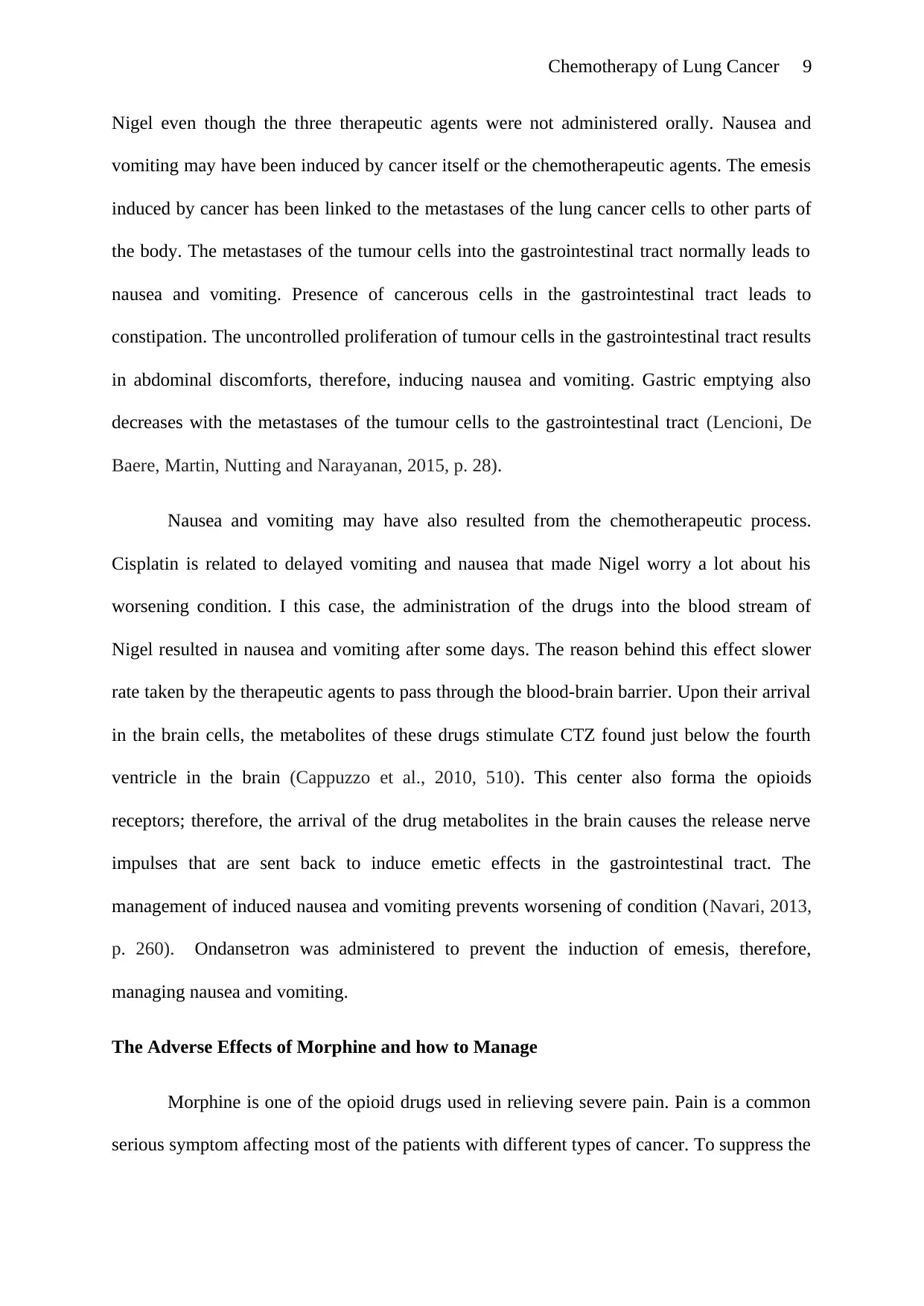
Chemotherapy of Lung Cancer 9
Nigel even though the three therapeutic agents were not administered orally. Nausea and
vomiting may have been induced by cancer itself or the chemotherapeutic agents. The emesis
induced by cancer has been linked to the metastases of the lung cancer cells to other parts of
the body. The metastases of the tumour cells into the gastrointestinal tract normally leads to
nausea and vomiting. Presence of cancerous cells in the gastrointestinal tract leads to
constipation. The uncontrolled proliferation of tumour cells in the gastrointestinal tract results
in abdominal discomforts, therefore, inducing nausea and vomiting. Gastric emptying also
decreases with the metastases of the tumour cells to the gastrointestinal tract (Lencioni, De
Baere, Martin, Nutting and Narayanan, 2015, p. 28).
Nausea and vomiting may have also resulted from the chemotherapeutic process.
Cisplatin is related to delayed vomiting and nausea that made Nigel worry a lot about his
worsening condition. I this case, the administration of the drugs into the blood stream of
Nigel resulted in nausea and vomiting after some days. The reason behind this effect slower
rate taken by the therapeutic agents to pass through the blood-brain barrier. Upon their arrival
in the brain cells, the metabolites of these drugs stimulate CTZ found just below the fourth
ventricle in the brain (Cappuzzo et al., 2010, 510). This center also forma the opioids
receptors; therefore, the arrival of the drug metabolites in the brain causes the release nerve
impulses that are sent back to induce emetic effects in the gastrointestinal tract. The
management of induced nausea and vomiting prevents worsening of condition (Navari, 2013,
p. 260). Ondansetron was administered to prevent the induction of emesis, therefore,
managing nausea and vomiting.
The Adverse Effects of Morphine and how to Manage
Morphine is one of the opioid drugs used in relieving severe pain. Pain is a common
serious symptom affecting most of the patients with different types of cancer. To suppress the
Nigel even though the three therapeutic agents were not administered orally. Nausea and
vomiting may have been induced by cancer itself or the chemotherapeutic agents. The emesis
induced by cancer has been linked to the metastases of the lung cancer cells to other parts of
the body. The metastases of the tumour cells into the gastrointestinal tract normally leads to
nausea and vomiting. Presence of cancerous cells in the gastrointestinal tract leads to
constipation. The uncontrolled proliferation of tumour cells in the gastrointestinal tract results
in abdominal discomforts, therefore, inducing nausea and vomiting. Gastric emptying also
decreases with the metastases of the tumour cells to the gastrointestinal tract (Lencioni, De
Baere, Martin, Nutting and Narayanan, 2015, p. 28).
Nausea and vomiting may have also resulted from the chemotherapeutic process.
Cisplatin is related to delayed vomiting and nausea that made Nigel worry a lot about his
worsening condition. I this case, the administration of the drugs into the blood stream of
Nigel resulted in nausea and vomiting after some days. The reason behind this effect slower
rate taken by the therapeutic agents to pass through the blood-brain barrier. Upon their arrival
in the brain cells, the metabolites of these drugs stimulate CTZ found just below the fourth
ventricle in the brain (Cappuzzo et al., 2010, 510). This center also forma the opioids
receptors; therefore, the arrival of the drug metabolites in the brain causes the release nerve
impulses that are sent back to induce emetic effects in the gastrointestinal tract. The
management of induced nausea and vomiting prevents worsening of condition (Navari, 2013,
p. 260). Ondansetron was administered to prevent the induction of emesis, therefore,
managing nausea and vomiting.
The Adverse Effects of Morphine and how to Manage
Morphine is one of the opioid drugs used in relieving severe pain. Pain is a common
serious symptom affecting most of the patients with different types of cancer. To suppress the

Chemotherapy of Lung Cancer 10
chronic pain affecting Nigel. Prolonged use of morphine leads to a state of dependence
(Caraceni et al, 2012, p. 68). The dependence of the drug has various adverse effects. One of
the common adverse effects of morphine alteration of normal sleep. The metabolites of
morphine pass through the blood-brain barrier and enter into the sleep receptors in the
hypothalamus of the brain. This leads to induction of impulses that causes rapid eye
movement and alteration of normal sleeping patterns. Chronic dependence on the drug leads
to complete sedation, therefore, affecting how the brain cells perceive pain. Morphine alters
with normal sleep wave, therefore, changing the patterns of normal sleep (Maemondo et al.,
2010, p. 2384). It is important to manage the adverse effects of morphine to promote recovery
and prevent the worsening of Nigel’s condition. The appropriate way of managing the
adverse effect is avoiding the prolonged use of the drug. The frequency of using the drug
should also be reduced to avoid prevent drug addiction.
chronic pain affecting Nigel. Prolonged use of morphine leads to a state of dependence
(Caraceni et al, 2012, p. 68). The dependence of the drug has various adverse effects. One of
the common adverse effects of morphine alteration of normal sleep. The metabolites of
morphine pass through the blood-brain barrier and enter into the sleep receptors in the
hypothalamus of the brain. This leads to induction of impulses that causes rapid eye
movement and alteration of normal sleeping patterns. Chronic dependence on the drug leads
to complete sedation, therefore, affecting how the brain cells perceive pain. Morphine alters
with normal sleep wave, therefore, changing the patterns of normal sleep (Maemondo et al.,
2010, p. 2384). It is important to manage the adverse effects of morphine to promote recovery
and prevent the worsening of Nigel’s condition. The appropriate way of managing the
adverse effect is avoiding the prolonged use of the drug. The frequency of using the drug
should also be reduced to avoid prevent drug addiction.
Secure Best Marks with AI Grader
Need help grading? Try our AI Grader for instant feedback on your assignments.
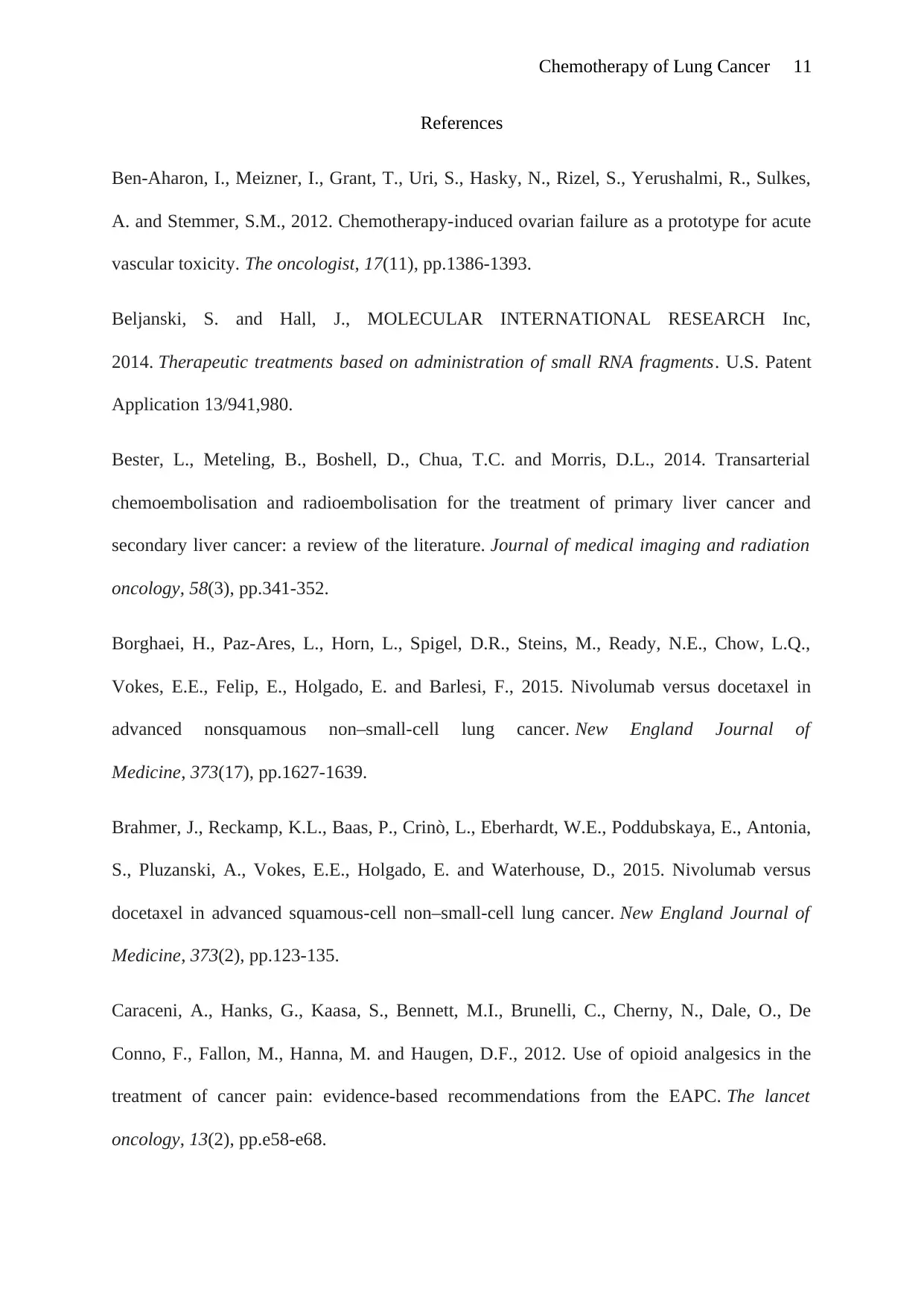
Chemotherapy of Lung Cancer 11
References
Ben-Aharon, I., Meizner, I., Grant, T., Uri, S., Hasky, N., Rizel, S., Yerushalmi, R., Sulkes,
A. and Stemmer, S.M., 2012. Chemotherapy-induced ovarian failure as a prototype for acute
vascular toxicity. The oncologist, 17(11), pp.1386-1393.
Beljanski, S. and Hall, J., MOLECULAR INTERNATIONAL RESEARCH Inc,
2014. Therapeutic treatments based on administration of small RNA fragments. U.S. Patent
Application 13/941,980.
Bester, L., Meteling, B., Boshell, D., Chua, T.C. and Morris, D.L., 2014. Transarterial
chemoembolisation and radioembolisation for the treatment of primary liver cancer and
secondary liver cancer: a review of the literature. Journal of medical imaging and radiation
oncology, 58(3), pp.341-352.
Borghaei, H., Paz-Ares, L., Horn, L., Spigel, D.R., Steins, M., Ready, N.E., Chow, L.Q.,
Vokes, E.E., Felip, E., Holgado, E. and Barlesi, F., 2015. Nivolumab versus docetaxel in
advanced nonsquamous non–small-cell lung cancer. New England Journal of
Medicine, 373(17), pp.1627-1639.
Brahmer, J., Reckamp, K.L., Baas, P., Crinò, L., Eberhardt, W.E., Poddubskaya, E., Antonia,
S., Pluzanski, A., Vokes, E.E., Holgado, E. and Waterhouse, D., 2015. Nivolumab versus
docetaxel in advanced squamous-cell non–small-cell lung cancer. New England Journal of
Medicine, 373(2), pp.123-135.
Caraceni, A., Hanks, G., Kaasa, S., Bennett, M.I., Brunelli, C., Cherny, N., Dale, O., De
Conno, F., Fallon, M., Hanna, M. and Haugen, D.F., 2012. Use of opioid analgesics in the
treatment of cancer pain: evidence-based recommendations from the EAPC. The lancet
oncology, 13(2), pp.e58-e68.
References
Ben-Aharon, I., Meizner, I., Grant, T., Uri, S., Hasky, N., Rizel, S., Yerushalmi, R., Sulkes,
A. and Stemmer, S.M., 2012. Chemotherapy-induced ovarian failure as a prototype for acute
vascular toxicity. The oncologist, 17(11), pp.1386-1393.
Beljanski, S. and Hall, J., MOLECULAR INTERNATIONAL RESEARCH Inc,
2014. Therapeutic treatments based on administration of small RNA fragments. U.S. Patent
Application 13/941,980.
Bester, L., Meteling, B., Boshell, D., Chua, T.C. and Morris, D.L., 2014. Transarterial
chemoembolisation and radioembolisation for the treatment of primary liver cancer and
secondary liver cancer: a review of the literature. Journal of medical imaging and radiation
oncology, 58(3), pp.341-352.
Borghaei, H., Paz-Ares, L., Horn, L., Spigel, D.R., Steins, M., Ready, N.E., Chow, L.Q.,
Vokes, E.E., Felip, E., Holgado, E. and Barlesi, F., 2015. Nivolumab versus docetaxel in
advanced nonsquamous non–small-cell lung cancer. New England Journal of
Medicine, 373(17), pp.1627-1639.
Brahmer, J., Reckamp, K.L., Baas, P., Crinò, L., Eberhardt, W.E., Poddubskaya, E., Antonia,
S., Pluzanski, A., Vokes, E.E., Holgado, E. and Waterhouse, D., 2015. Nivolumab versus
docetaxel in advanced squamous-cell non–small-cell lung cancer. New England Journal of
Medicine, 373(2), pp.123-135.
Caraceni, A., Hanks, G., Kaasa, S., Bennett, M.I., Brunelli, C., Cherny, N., Dale, O., De
Conno, F., Fallon, M., Hanna, M. and Haugen, D.F., 2012. Use of opioid analgesics in the
treatment of cancer pain: evidence-based recommendations from the EAPC. The lancet
oncology, 13(2), pp.e58-e68.
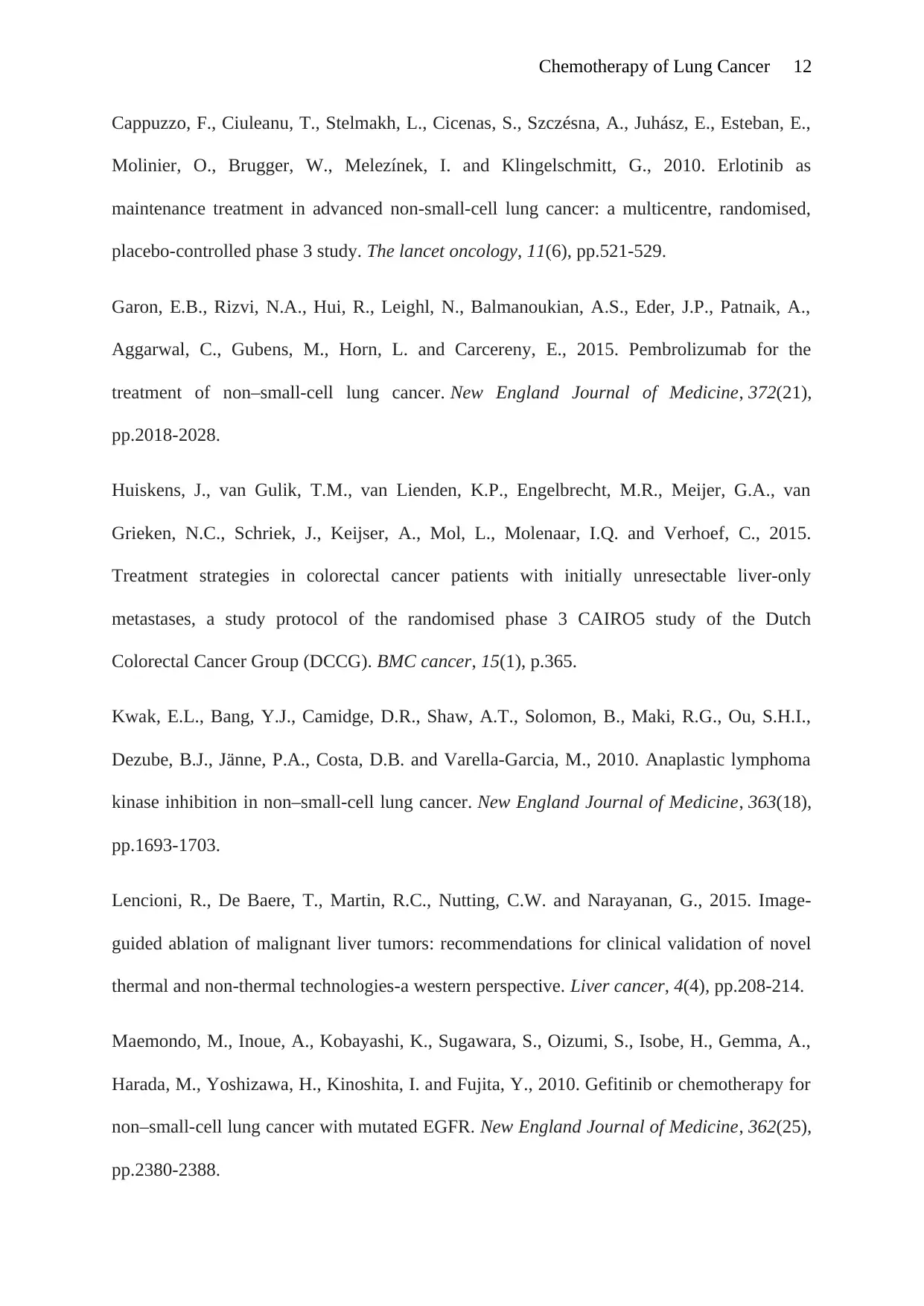
Chemotherapy of Lung Cancer 12
Cappuzzo, F., Ciuleanu, T., Stelmakh, L., Cicenas, S., Szczésna, A., Juhász, E., Esteban, E.,
Molinier, O., Brugger, W., Melezínek, I. and Klingelschmitt, G., 2010. Erlotinib as
maintenance treatment in advanced non-small-cell lung cancer: a multicentre, randomised,
placebo-controlled phase 3 study. The lancet oncology, 11(6), pp.521-529.
Garon, E.B., Rizvi, N.A., Hui, R., Leighl, N., Balmanoukian, A.S., Eder, J.P., Patnaik, A.,
Aggarwal, C., Gubens, M., Horn, L. and Carcereny, E., 2015. Pembrolizumab for the
treatment of non–small-cell lung cancer. New England Journal of Medicine, 372(21),
pp.2018-2028.
Huiskens, J., van Gulik, T.M., van Lienden, K.P., Engelbrecht, M.R., Meijer, G.A., van
Grieken, N.C., Schriek, J., Keijser, A., Mol, L., Molenaar, I.Q. and Verhoef, C., 2015.
Treatment strategies in colorectal cancer patients with initially unresectable liver-only
metastases, a study protocol of the randomised phase 3 CAIRO5 study of the Dutch
Colorectal Cancer Group (DCCG). BMC cancer, 15(1), p.365.
Kwak, E.L., Bang, Y.J., Camidge, D.R., Shaw, A.T., Solomon, B., Maki, R.G., Ou, S.H.I.,
Dezube, B.J., Jänne, P.A., Costa, D.B. and Varella-Garcia, M., 2010. Anaplastic lymphoma
kinase inhibition in non–small-cell lung cancer. New England Journal of Medicine, 363(18),
pp.1693-1703.
Lencioni, R., De Baere, T., Martin, R.C., Nutting, C.W. and Narayanan, G., 2015. Image-
guided ablation of malignant liver tumors: recommendations for clinical validation of novel
thermal and non-thermal technologies-a western perspective. Liver cancer, 4(4), pp.208-214.
Maemondo, M., Inoue, A., Kobayashi, K., Sugawara, S., Oizumi, S., Isobe, H., Gemma, A.,
Harada, M., Yoshizawa, H., Kinoshita, I. and Fujita, Y., 2010. Gefitinib or chemotherapy for
non–small-cell lung cancer with mutated EGFR. New England Journal of Medicine, 362(25),
pp.2380-2388.
Cappuzzo, F., Ciuleanu, T., Stelmakh, L., Cicenas, S., Szczésna, A., Juhász, E., Esteban, E.,
Molinier, O., Brugger, W., Melezínek, I. and Klingelschmitt, G., 2010. Erlotinib as
maintenance treatment in advanced non-small-cell lung cancer: a multicentre, randomised,
placebo-controlled phase 3 study. The lancet oncology, 11(6), pp.521-529.
Garon, E.B., Rizvi, N.A., Hui, R., Leighl, N., Balmanoukian, A.S., Eder, J.P., Patnaik, A.,
Aggarwal, C., Gubens, M., Horn, L. and Carcereny, E., 2015. Pembrolizumab for the
treatment of non–small-cell lung cancer. New England Journal of Medicine, 372(21),
pp.2018-2028.
Huiskens, J., van Gulik, T.M., van Lienden, K.P., Engelbrecht, M.R., Meijer, G.A., van
Grieken, N.C., Schriek, J., Keijser, A., Mol, L., Molenaar, I.Q. and Verhoef, C., 2015.
Treatment strategies in colorectal cancer patients with initially unresectable liver-only
metastases, a study protocol of the randomised phase 3 CAIRO5 study of the Dutch
Colorectal Cancer Group (DCCG). BMC cancer, 15(1), p.365.
Kwak, E.L., Bang, Y.J., Camidge, D.R., Shaw, A.T., Solomon, B., Maki, R.G., Ou, S.H.I.,
Dezube, B.J., Jänne, P.A., Costa, D.B. and Varella-Garcia, M., 2010. Anaplastic lymphoma
kinase inhibition in non–small-cell lung cancer. New England Journal of Medicine, 363(18),
pp.1693-1703.
Lencioni, R., De Baere, T., Martin, R.C., Nutting, C.W. and Narayanan, G., 2015. Image-
guided ablation of malignant liver tumors: recommendations for clinical validation of novel
thermal and non-thermal technologies-a western perspective. Liver cancer, 4(4), pp.208-214.
Maemondo, M., Inoue, A., Kobayashi, K., Sugawara, S., Oizumi, S., Isobe, H., Gemma, A.,
Harada, M., Yoshizawa, H., Kinoshita, I. and Fujita, Y., 2010. Gefitinib or chemotherapy for
non–small-cell lung cancer with mutated EGFR. New England Journal of Medicine, 362(25),
pp.2380-2388.

Chemotherapy of Lung Cancer 13
National Lung Screening Trial Research Team, 2011. Reduced lung-cancer mortality with
low-dose computed tomographic screening. New England Journal of Medicine, 365(5),
pp.395-409.
Navari, R.M., 2013. Management of chemotherapy-induced nausea and
vomiting. Drugs, 73(3), pp.249-262.
Nicholson, A.B., Watson, G.R., Derry, S. and Wiffen, P.J., 2017. Methadone for cancer
pain. Cochrane Database of Systematic Reviews, (2).
Nowacki, M., Peterson, M., Kloskowski, T., McCabe, E., Guiral, D.C., Polom, K., Pietkun,
K., Zegarska, B., Pokrywczynska, M., Drewa, T. and Roviello, F., 2017. Nanoparticle as a
novel tool in hyperthermic intraperitoneal and pressurized intraperitoneal aerosol
chemotheprapy to treat patients with peritoneal carcinomatosis. Oncotarget, 8(44), p.78208.
Reck, M., Rodríguez-Abreu, D., Robinson, A.G., Hui, R., Csőszi, T., Fülöp, A., Gottfried,
M., Peled, N., Tafreshi, A., Cuffe, S. and O’Brien, M., 2016. Pembrolizumab versus
chemotherapy for PD-L1–positive non–small-cell lung cancer. New England Journal of
Medicine, 375(19), pp.1823-1833.
Rosell, R., Carcereny, E., Gervais, R., Vergnenegre, A., Massuti, B., Felip, E., Palmero, R.,
Garcia-Gomez, R., Pallares, C., Sanchez, J.M. and Porta, R., 2012. Erlotinib versus standard
chemotherapy as first-line treatment for European patients with advanced EGFR mutation-
positive non-small-cell lung cancer (EURTAC): a multicentre, open-label, randomised phase
3 trial. The lancet oncology, 13(3), pp.239-246.
Stewart, A.K., Rajkumar, S.V., Dimopoulos, M.A., Masszi, T., Špička, I., Oriol, A., Hájek,
R., Rosiñol, L., Siegel, D.S., Mihaylov, G.G. and Goranova-Marinova, V., 2015.
Carfilzomib, lenalidomide, and dexamethasone for relapsed multiple myeloma. New England
Journal of Medicine, 372(2), pp.142-152.
National Lung Screening Trial Research Team, 2011. Reduced lung-cancer mortality with
low-dose computed tomographic screening. New England Journal of Medicine, 365(5),
pp.395-409.
Navari, R.M., 2013. Management of chemotherapy-induced nausea and
vomiting. Drugs, 73(3), pp.249-262.
Nicholson, A.B., Watson, G.R., Derry, S. and Wiffen, P.J., 2017. Methadone for cancer
pain. Cochrane Database of Systematic Reviews, (2).
Nowacki, M., Peterson, M., Kloskowski, T., McCabe, E., Guiral, D.C., Polom, K., Pietkun,
K., Zegarska, B., Pokrywczynska, M., Drewa, T. and Roviello, F., 2017. Nanoparticle as a
novel tool in hyperthermic intraperitoneal and pressurized intraperitoneal aerosol
chemotheprapy to treat patients with peritoneal carcinomatosis. Oncotarget, 8(44), p.78208.
Reck, M., Rodríguez-Abreu, D., Robinson, A.G., Hui, R., Csőszi, T., Fülöp, A., Gottfried,
M., Peled, N., Tafreshi, A., Cuffe, S. and O’Brien, M., 2016. Pembrolizumab versus
chemotherapy for PD-L1–positive non–small-cell lung cancer. New England Journal of
Medicine, 375(19), pp.1823-1833.
Rosell, R., Carcereny, E., Gervais, R., Vergnenegre, A., Massuti, B., Felip, E., Palmero, R.,
Garcia-Gomez, R., Pallares, C., Sanchez, J.M. and Porta, R., 2012. Erlotinib versus standard
chemotherapy as first-line treatment for European patients with advanced EGFR mutation-
positive non-small-cell lung cancer (EURTAC): a multicentre, open-label, randomised phase
3 trial. The lancet oncology, 13(3), pp.239-246.
Stewart, A.K., Rajkumar, S.V., Dimopoulos, M.A., Masszi, T., Špička, I., Oriol, A., Hájek,
R., Rosiñol, L., Siegel, D.S., Mihaylov, G.G. and Goranova-Marinova, V., 2015.
Carfilzomib, lenalidomide, and dexamethasone for relapsed multiple myeloma. New England
Journal of Medicine, 372(2), pp.142-152.
Paraphrase This Document
Need a fresh take? Get an instant paraphrase of this document with our AI Paraphraser
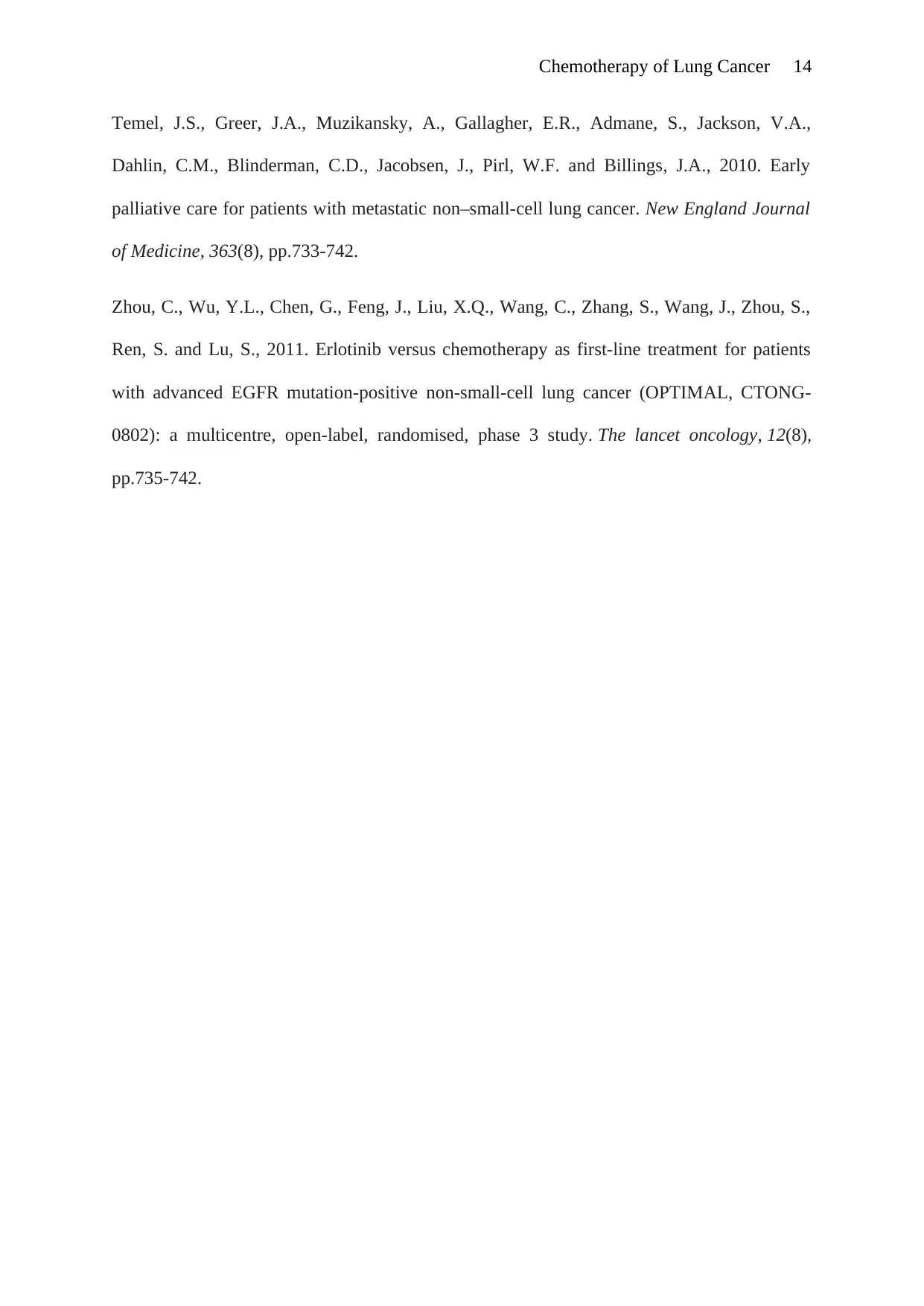
Chemotherapy of Lung Cancer 14
Temel, J.S., Greer, J.A., Muzikansky, A., Gallagher, E.R., Admane, S., Jackson, V.A.,
Dahlin, C.M., Blinderman, C.D., Jacobsen, J., Pirl, W.F. and Billings, J.A., 2010. Early
palliative care for patients with metastatic non–small-cell lung cancer. New England Journal
of Medicine, 363(8), pp.733-742.
Zhou, C., Wu, Y.L., Chen, G., Feng, J., Liu, X.Q., Wang, C., Zhang, S., Wang, J., Zhou, S.,
Ren, S. and Lu, S., 2011. Erlotinib versus chemotherapy as first-line treatment for patients
with advanced EGFR mutation-positive non-small-cell lung cancer (OPTIMAL, CTONG-
0802): a multicentre, open-label, randomised, phase 3 study. The lancet oncology, 12(8),
pp.735-742.
Temel, J.S., Greer, J.A., Muzikansky, A., Gallagher, E.R., Admane, S., Jackson, V.A.,
Dahlin, C.M., Blinderman, C.D., Jacobsen, J., Pirl, W.F. and Billings, J.A., 2010. Early
palliative care for patients with metastatic non–small-cell lung cancer. New England Journal
of Medicine, 363(8), pp.733-742.
Zhou, C., Wu, Y.L., Chen, G., Feng, J., Liu, X.Q., Wang, C., Zhang, S., Wang, J., Zhou, S.,
Ren, S. and Lu, S., 2011. Erlotinib versus chemotherapy as first-line treatment for patients
with advanced EGFR mutation-positive non-small-cell lung cancer (OPTIMAL, CTONG-
0802): a multicentre, open-label, randomised, phase 3 study. The lancet oncology, 12(8),
pp.735-742.
1 out of 14
Related Documents
Your All-in-One AI-Powered Toolkit for Academic Success.
+13062052269
info@desklib.com
Available 24*7 on WhatsApp / Email
![[object Object]](/_next/static/media/star-bottom.7253800d.svg)
Unlock your academic potential
© 2024 | Zucol Services PVT LTD | All rights reserved.




